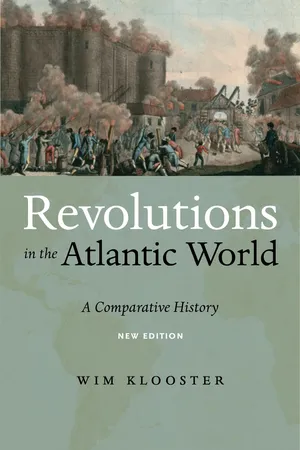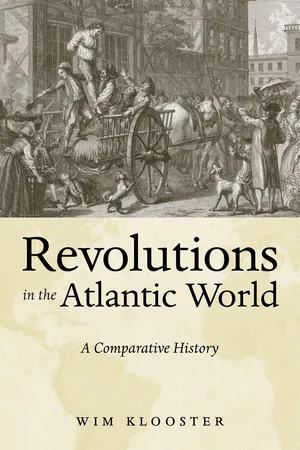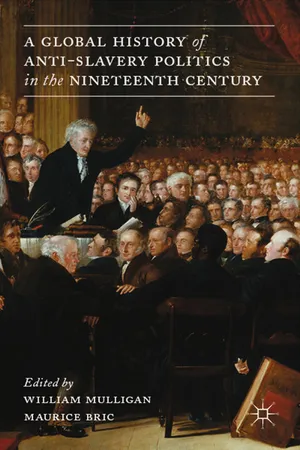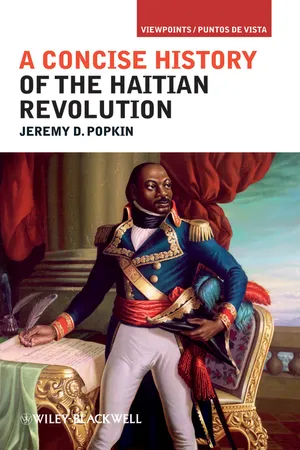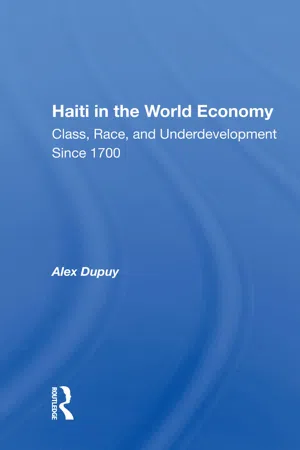History
Jean Jacques Dessalines
Jean Jacques Dessalines was a key figure in the Haitian Revolution and the first ruler of an independent Haiti. He played a crucial role in leading the slave rebellion against French colonial rule and ultimately declared Haiti's independence in 1804. Dessalines is remembered for his fierce determination and leadership in the fight for freedom and the establishment of Haiti as the first independent black republic.
Written by Perlego with AI-assistance
Related key terms
11 Key excerpts on "Jean Jacques Dessalines"
- eBook - ePub
The Early Haitian State and the Question of Political Legitimacy
American and British Representations of Haiti, 1804—1824
- James Forde(Author)
- 2020(Publication Date)
- Palgrave Macmillan(Publisher)
9American Perceptions of the New World’s First Black Emperor
In America, Haiti’s newly declared independence led to a projection of anxieties over the presence of a black republic so close to America’s southern slave-owning states. Plantation owners worried that the successful revolution of slaves against the might of Napoleonic France would provide inspiration for slaves throughout the Americas, and that this revolutionary spirit would be transported to the southern states of America. As a number of historians have demonstrated, at a time when American newspapers and politicians expressed such concern over the presence of the newly independent black state, open expressions of support for the ex-slave leader responsible for the deaths of thousands of white colonists were almost impossible to assert, and a variety of American newspapers in fact seemed to thrive on such stories as they sought to outline the supposedly savage and brutish nature of the black revolutionaries.10 In this tense and fearful climate, news of the massacres of the French inhabitants of the newly independent Haiti essentially eradicated the prospect of American governmental support for Haiti’s claims to sovereignty and political recognition and, as such, generally ended sympathetic portrayals of Haiti’s leader.11 - eBook - ePub
Jeffersonian America
Creation, Context, and Legacy
- Julia Gaffield(Author)
- 2016(Publication Date)
- University of Virginia Press(Publisher)
The valuing of the revolution over the independence period is perhaps because the first decades after January 1, 1804, do not match our idealized version of the Haitian Revolution as a moment when the disenfranchised won, when equality triumphed, and when racial barriers fell. The independence period makes clear that many of the colonial hierarchies remained—sometimes in a reimagined way—after the end of the revolution. There are some aspects of the independence period that we cannot study in the same celebratory way as the revolution. The massacres initiated by Dessalines, the revised labor regime that too much resembled slavery, the militarization of society, the overthrow of one dictator after another—we cannot champion these as the roots of the enlightened modern world as we do the rest of the ideals laid out in the Haitian Revolution. To sharpen our sense of these anomalies and paradoxes arising from the Haitian Revolution, this volume concentrates on a single pivotal document, the text generally known as the Haitian Declaration of Independence.“Take then before him the oath of living free and independent,” Jean-Jacques Dessalines announced to a crowd gathered in the city of Gonaïves on January 1, 1804, “and to prefer death to anything that will try to place you back under the yoke. Swear at last, to pursue forever the traitors and the enemies of your independence.” Dessalines, the leader of the victorious Armée Indigène in Saint-Domingue, proclaimed what was, in effect if not in name, one of the world’s earliest declarations of independence. Before July 1776, no people or nation, country or state, had formally declared its “independence” to the world; adoption of the model for declaring independence created by the representatives of the United States was piecemeal and slow. In the years between American and Haitian independence, there had been only two similar announcements, both patterned after the American template: Vermont’s declaration of independence from the new United States (1777) and the manifesto issued by the Flemish estates when they seceded briefly from the Austrian Empire in 1790. - eBook - ePub
Revolutions in the Atlantic World, New Edition
A Comparative History
- Wim Klooster(Author)
- 2018(Publication Date)
- NYU Press(Publisher)
117In October 1806, Dessalines’s brief rule came to a violent end. Having alienated mulatto landowners and foreign merchants, the emperor misbehaved again during a tour of the south and began to review the legal titles to estates confiscated in the last stage of the revolution. He was doomed when a revolt spread from Les Cayes to Port-au-Prince and many officers and soldiers—upset about overdue debts—joined the rebels. The army leader was killed by his own troops and his corpse mutilated, dragged through the streets of Port-au-Prince and exposed in the parade ground. The dictator was dead.118Although Dessalines’s reign extended the rule of fear and violence for another two years after independence, 1804 was in many ways a new beginning. Within two weeks, blacks and mulattoes who had left the colony during the revolution were told they could return. All those arriving from the United States on North American ships were promised forty gourdes. Dessalines also tried to increase his population by welcoming blacks from Africa. He offered to open Haitian ports to British slave ships, but the Jamaican slavers turned down his plan to give them the exclusive right to sell enslaved Africans in the black nation. Nor did Dessalines’s successor Henri Christophe shy away from buying Africans in order to give them their freedom in Haiti.119In an attempt to forge unity, the constitution of May 1805 stipulated that “all citizens of Haiti will henceforth be known under the generic denomination of blacks.” Haitian historian Beaubrun Ardouin (1796–1865) commented that this was contrived, given the presence of naturalized Poles, Germans, and Frenchmen. It would have been more appropriate to call the citizens Haitians. The French lieutenant-general Pamphile de Lacroix, who had arrived with the expedition of Leclerc, had found that the terms “negro” and “mulatto” were experienced as hurtful by Haitians, who shared a hatred of “the old days, the old slavery.” Nonetheless, old habits did not fade away overnight. An English visitor noted a continued display of deference toward whites.120 - eBook - ePub
Revolutions in the Atlantic World
A Comparative History
- Wim Klooster(Author)
- 2009(Publication Date)
- NYU Press(Publisher)
114When the bloodletting was done, Dessalines stated: “We have repaid these cannibals war for war, crime for crime, outrage for outrage. Yes, I have saved my country, I have avenged America!”115 His ego inflated, he was eager to match Napoleon when the news reached him that the senate in Paris had offered the Corsican the title of Emperor. Upon his own suggestion to his generals that he should be named Emperor of Haiti, Dessalines was proclaimed Jean-Jacques the First, Emperor of Haiti. The coronation ceremony took place on October 8, seven weeks before that of Napoleon. In the two years that followed, Dessalines delegated even less than Napoleon, making himself the sole ruler. He refused to respect individual rights, shrugged at the suggestion to separate the powers, and never stopped victimizing anybody, of whatever ethnicity, who dared to cross him. It was no surprise that he accepted a challenge from the eastern part of the island, whose governor, Louis Ferrand, threatened to seize Haitians and sell them into slavery. But Dessalines’ attack of Santo Domingo, defended by a garrison under Ferrand, in March 1805 failed miserably, forcing Jean-Jacques the First to withdraw his troops. On the way back to Haiti, thousands of rural dwellers were taken prisoner and put to work on fortifications in Dessalines’ state or incorporated into his army.116In October 1806, Dessalines’ brief rule came to a violent end. Having alienated mulatto landowners and foreign merchants, the emperor misbehaved again during a tour of the south and began to review the legal titles to estates confiscated in the last stage of the revolution. He was doomed when a revolt spread from Les Cayes to Port-au-Prince and many officers and soldiers—upset about overdue debts—joined the rebels. Killed by his own troops, the corpse of the army leader was mutilated, dragged through the streets of Port-au-Prince, and exposed in the parade-ground. The dictator was dead.117 - eBook - ePub
Identity and Ideology in Haiti
The Children of Sans Souci, Dessalines/Toussaint, and Pétion
- Paul C. Mocombe(Author)
- 2018(Publication Date)
- Routledge(Publisher)
Following his European campaign, Napoleon Bonaparte, wary of Tous-saint’s great power in the colony, sent 82,000 of his battle-proven troops commanded by the mulattoes Alexandre Pétion, Jean-Pierre Boyer, and his brother-in-law, General Charles Leclerc, a fleet of warships, canons, munitions, and dogs in order to quell the rebellion and recapture Haiti as a slave colony. Whereas the Affranchis surrendered, the Africans under the leadership of Sans Souci and Macaya continued their warfare against the French and Affranchis from the mountains. Two years of war ended in a stalemate; however, the French treacherously arrested Toussaint Louverture during a meeting in June 1802. He was exiled to France and died in the Fort de Joux prison high in the cold Alpine mountains of Jura in April 1803.With the arrest, and eventual death, of Toussaint, Jean-Jacques Dessa-lines, a trained oungan in the traditions of Makandal and Boukman, whose dislike for the whites and mulatto Affranchis was not shared by Louverture, formed a shaky alliance with the maroon Africans, free blacks, and mulattoes (under the leadership of Alexandre Pétion who was sent back under Leclerc’s army to reclaim the island for France) and emerged as the new leader of the Haitian Revolution, bringing it, with the aid of Henri Christophe, Francois Capois-la-Mort, and the maroon Africans to its ultimate climax, the first black independent nation in the world on January 1, 1804, and the only successful slave rebellion in recorded history.Unlike Toussaint, Dessalines was a creole field slave interpellated and ounganified/manboified by the Vodou ideology and ideological apparatuses of the Africans. He had no formal Western education and disagreed with Toussaint over the roles of the mulattoes and whites in the revolution. Nonetheless, in his eventual move to liberate Haiti, he united with the maroon Africans (Macaya, Sans Souci, etc.), free blacks, and mulatto elites led by Alexandre Pétion. Haiti’s revolution against colonialism and slavery was the first successful black movement resulting in an independent state headed by so-called blacks. On January 1, 1804, Dessalines, to honor the Taino natives who had been massacred by the Spanish, renamed the island its original Tainoian name, Haiti or Ayi-ti (mountainous land). Since these glorious events, Haiti has been the pariah of the West bearing the mark of the poorest country in the Hemisphere. This distinction is a product of the racial-class divisions and struggle for power between the mulattoes, free blacks, and the Africans, which would continue in Haiti during and following the Revolution and the death of Jean-Jacques Dessalines. - W. Mulligan, M. Bric, W. Mulligan, M. Bric(Authors)
- 2013(Publication Date)
- Palgrave Macmillan(Publisher)
1“Liberté, Indépendance”: Haitian Anti-slavery and National Independence
Julia Gaffield“From the moment that I realized that my compatriots had taken a vow to prefer death to servitude,” general in chief of the Armée indigène, Jean-Jacques Dessalines, wrote in his military journal at the end of the Haitian Revolution, “I promised to pursue with determination the French, our executioners.”1 While the Haitian revolution had begun in 1791 with a coordinated slave uprising in the northern plain of Saint-Domingue, the battle only became a war for independence in 1802 when Napoleon’s army reinvaded the colony and sparked rumours of a reinstitution of slavery. Dessalines declared that to ensure the end of slavery, the island had to break away from the French Empire. In November 1803, the defeated French army set sail from the city of Cap Français and only left one small contingent of troops, who escaped to the city of Santo Domingo on the eastern side of the island. The coalition of former slaves and former free people of colour would now rule. “Put in my hands your sworn willingness to live free and independent,” Dessalines proclaimed on 1 January 1804 in the Haitian Declaration of Independence, “and to prefer death to all that would put you back under the yoke.”2 Freedom for all citizens had been achieved by the victory in the war for independence. The country was renamed “Hayti”, and all “Haytians” would thereby, it was believed, be forever free from servitude.Throughout Latin America and the Caribbean, struggles for slave emancipation and battles against colonial rule often came together during wars of independence. In most contexts, however, the abolition of slavery came as a by-product of the main goal of political autonomy. Within this broader history, Haiti represents a unique case in that anti-slavery was, from the first, the driving force behind the struggle for independence. The centrality of anti-slavery in the formation of the Haitian state shaped the years after independence and the policies of the first three national leaders: Jean-Jacques Dessalines, Alexandre Pétion, and Henry Christophe. These leaders ruled very different governments and initiated different policies, but all of them had to grapple with the constrained space that Haiti occupied in the early nineteenth century and each had to balance the contradictions created by ideologies of universal revolution within the limits of nationhood. The dilemma that confronted the Haitian leadership produced complex results, and the national projects of each leader as articulated on paper did not always reflect the realities of the Haitian state.- eBook - ePub
- Jeremy D. Popkin(Author)
- 2011(Publication Date)
- Wiley-Blackwell(Publisher)
4 On 17 October 1806, the conspirators ambushed and killed Dessalines at Pont Rouge as he was travelling back to Port-au-Prince from a trip to the North Province. Several of his closest supporters, including Capois-la-Mort (“Capois-Death”), the hero of the victory at Vertières three years earlier, were also killed.At the time of his death Dessalines had become extremely unpopular: after his assassination, a crowd tore his body apart. According to legend, it was left to a local madwoman, Défilée-la-folle (“Crazy Défilée”), to gather the scattered remains and bury them. As time passed, however, attitudes toward the man who had rallied the population to defeat the French changed. Eventually, Dessalines became the only Haitian leader to be incorporated into the pantheon of vodou spirits or lwa , where he is recognized as one of the avatars of the warrior Ogou or Ogun.5 In contrast to Toussaint Louverture, who had never entirely abandoned the hope of coexistence with the whites and who never took the ultimate step of declaring independence from France, Dessalines has been transformed into a symbol of black liberation and national self-assertion. Haiti’s national anthem, composed in 1904 to mark the hundredth anniversary of independence, is called “La Dessalinienne,” and its words “United let us march! Let there be no traitors in our ranks! Let us be masters of our soil!” recall his ambition of bringing the different groups of the population together and eliminating white claims to property ownership. Whereas Toussaint Louverture remains better known in the world at large, in Haiti it is Jean-Jacques Dessalines, “this proud deity whose courage defied the murderous points of bayonets,” as one twentieth-century Haitian historian called him,6 - eBook - ePub
The Haitian Revolution
Capitalism, Slavery and Counter-Modernity
- Eduardo Grüner, Ramsey McGlazer(Authors)
- 2019(Publication Date)
- Polity(Publisher)
This is another indication of the revolution’s originality. Those who led the slaves in the seizure of power established first une république nègre under Toussaint, but then what they called an empire : Toussaint had given himself the title of Governor General and granted himself dictatorial powers, including a lifelong term and the ability to choose his own successor. Dessalines and Christophe were then “kings” or “emperors,” and Alexandre Pétion was “president.” At times, this was all happening at the same time: struggles among internal factions during the first years after the revolution at times became veritable civil war. These conflicts led to a level of fragmentation that was unheard of in such a small country. By 1810, all hopes for a unified nation-state had dissolved, leaving in their place four different political entities: in the South a republic led by Toussaint’s rival, the “mulatto” Rigaud; in the East, another republic with the “mulatto” Pétion at its helm; in the North, a so-called black state, led by Henri Christophe, which a year later would be redefined as a monarchy; and in the West, the Spanish colony of Santo Domingo, which had been reclaimed and partially occupied by revolutionaries since Toussaint’s time. Effectively incorporated as part of Haiti in 1822, Santo Domingo would regain its autonomy in 1844 (so that today, surreally, the independence that is celebrated, with all due pomp and circumstance, on Independence Day in the Dominican Republic is independence from Haiti, not from Spain). In other words, the heroic struggle against slavery, the fight for independence, the formation of the first black nation in human history – this whole process was one thing. But the construction of a “modern” nation-state was another thing altogether, a process that was considerably more difficult - Henry Stead, Edith Hall(Authors)
- 2015(Publication Date)
- Bloomsbury Academic(Publisher)
At the time of the revolution, the land that became Haiti was the French colony of Saint-Domingue; yet the British powers in Jamaica and the Spanish powers on the eastern side of the island, which later became the Dominican Republic, were also involved. While the Haitian Revolution drew inspiration from the French Revolution, the revolt that Toussaint led also compelled the French revolutionaries to confront the wider-reaching consequences of their political actions. Despite abolishing slavery in 1794, Napoleon restored it in 1802, and only two weeks later, on 6 June that year, Toussaint was arrested, transported to France and imprisoned there. He died the following April, but the revolution which he had led was not defeated, and on 1 January 1804 Dessalines declared the former colony independent, and reclaimed its former Arawak name of Haiti.James’s socialist awakening coincided with his arrival in Britain – not by chance – and it is as a social and political theorist that he is most renowned. His fervent anti-Stalinist Marxism, and his passionate advocacy of Pan-Africanism, has been the subject of much scholarly work, to the relative neglect of his creative writing. What is surprising about such neglect is that it disregards the important Marxist notion of the revolutionary responsibility of the artist. This responsibility is all too evident in Toussaint Louverture, which was clearly written as part of James’s push for social reform. Only the year before the play was staged, Georgi Dimitrov had foregrounded the need for the struggle against fascism to be fought in the cultural as well as the political sphere, when he addressed the Seventh Congress of the Communist International in August 1935.18 It is clear, then, that the affinities with Soviet communism should not be underestimated, and that these connections highlight the poignant alignment of the abolition of slavery with free elections, freedom of speech and the rule of law as examples of ‘proto-communist’ social progress triggered by popular radicalism.19- eBook - ePub
Haiti's New Dictatorship
The Coup, the Earthquake and the UN Occupation
- Justin Podur(Author)
- 2012(Publication Date)
- Pluto Press(Publisher)
Toussaint L’Ouverture used the language of the French Revolution (Liberty, Equality, Fraternity) and suggested that the Haitian revolution was only an attempt to live up to those ideals. Similarly, Haiti might have hoped that the United States, upon becoming independent, might embrace its independent neighbour. But the new republic, although in part based also on the ideals of the French Revolution, was also a genocidal settler state and a slave society. These realities coloured the U.S.’s policy toward Haiti much more than any shared revolutionary ideals. The U.S. refused to recognize Haiti and feared the example of a successful slave revolt.Jean-Jacques Dessalines, the former field slave who had led the final struggle for independence after Toussaint L’Ouverture was captured, declared himself Emperor upon victory, but was assassinated shortly afterward. Alexandre Petion, President of Haiti after Dessalines’s assassination, helped South American Revolutionary Simon Bolivar in the fight for independence against Spain. Bolivar ended up in exile in Haiti twice, in 1815 and 1816. Haiti provided Bolivar first with sanctuary, then with material, volunteers, and transport back to the continent to resume the fight. Petion’s condition: that Bolivar free the slaves in the territories he liberated. Bolivar modified the condition in the implementation, issuing a decree that slaves would be freed if they joined his army.EARLY INDEPENDENCE AND THE INDEMNITY TO FRANCEIn 1825, France issued the Royal Ordinance, calling for Haitians to pay a massive indemnity for winning the revolt and freeing themselves. The indemnity was for 150 million francs, based on the profits that could have been earned by colonists in the period: it represented France’s annual budget plus ten years of revenue from the plantations and estates that had been destroyed during the war. On top of this, French ships and commercial goods entering and leaving Haiti were to be discounted 50 per cent. The demands were delivered by heavily armed warships just off of Port-au-Prince. The French promised to recognize Haiti as an independent nation if the indemnity was paid. Haiti had fortified itself against another invasion, but was no naval power. Facing a blockade, the island economy was forced to acquiesce. A French bank loaned Haiti 30 million francs for the first instalment, deducting management fees and charging exorbitant interest: by the time payments were completed, Haiti was 6 million francs deeper in the hole. It took Haiti 122 years – until 1947 – to finish paying the indemnity debt.5 - eBook - ePub
Haiti In The World Economy
Class, Race, And Underdevelopment Since 1700
- Alex Dupuy(Author)
- 2019(Publication Date)
- Routledge(Publisher)
Haiti had won its independence, but at the cost of enormous human suffering and material destruction. It is estimated that the total number of dead following the expedition and the subsequent war of independence neared 150,000. Those permanently disabled were between 50,000 and 55,000 on the French side, and 100,000 to 130,000 on the Haitian side. The war of independence also left the economy in shambles. Le Cap, Port-de-Paix, Gonaives, and Saint-Marc were burned to the ground, and throughout the island plantations, sugar mills, shops, irrigation networks, wharfs, and domesticated and draft animals were destroyed. Though it is not possible to calculate the precise financial cost of the war, some put it at 1,144,258,948 francs (Auguste and Auguste 1985, 313-319). Haiti, in other words, inherited a shattered economy.Although the French army had left Haiti, French forces still remained in Spanish San Domingo and French citizens in Haiti. The freshly constituted independent nation-state was still on a war footing and feared a new French invasion. These fears were not unjustified. France wasted no time in lobbying the other major powers—Great Britain, Spain, and the United States—to isolate Haiti commercially and diplomatically, reminding them of the threat that such a recognition would pose to their own slaveholders. Blacks must be considered differently than whites, France argued, and the laws of national sovereignty must not apply to them. It was France's hope that by so isolating Haiti, it could consolidate its powers in western San Domingo and from there launch its attack to retake Haiti (Etienne 1982, 17). Neither the European powers nor the United States recognized Haiti's independence, but they did not suspend trade relations.The newly independent regime moved quickly to consolidate its power by imposing a military dictatorship on the country. Dessalines was proclaimed governor general for life, with the right to name his successor. As under Louverture, military generals and senior officers took charge of all the departments and subdivisions of the national territory. The military officers were also responsible for the administration of justice as well as the municipal administrations (Ardouin 1958, 6:9-12).One of the first major acts of the new dictatorship consisted of the extermination of the remaining French citizens in Haiti. In February 1804, Dessalines issued a decree ordering the arrest, trial, and execution by military officers of all those French citizens who had been guilty or suspected of participating in the murders and massacres of Haitians by Leclerc and Rochambeau during the last year of the French occupation. Military officers were placed in charge of judging the guilt or innocence of the accused, and this led the way wide open to a summary execution of French citizens by all those who had grievances against them. Dessalines had reached in practice the conclusion that Memmi would arrive at theoretically 163 years later, and which Sartre succinctly summarized: "There are neither good nor bad colonists: there are colonialists" (cited in Memmi 1967, xxv). National liberation must adopt a nationalist or ethnic character from which the colonialist must be excluded (Memmi 1967, 38-39).
Index pages curate the most relevant extracts from our library of academic textbooks. They’ve been created using an in-house natural language model (NLM), each adding context and meaning to key research topics.


